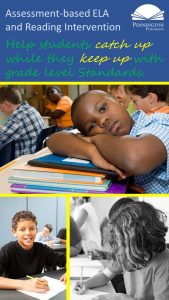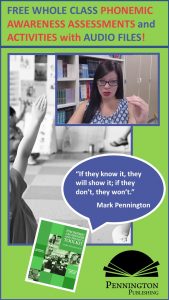The Science of Reading Intervention Program: Assessment-based Instruction
There’s never enough instructional time to teach students who struggle with reading.
However…
The Science of Reading Intervention Program: Assessment-based Instruction provides diagnostically-based instructional resources to individualize instruction for students grades 4–adult in 25 minutes per day for 18 weeks. Perfect for early-late schedules or Tier 3 pull-out instruction. Ideal for EL and ESL learners or students in Resource programs with IEPs. A great option for students in continuation school settings or community college and adult literacy programs with self-paced instructional modules.
Although it certainly makes sense to teach a comprehensive word recognition program to all struggling readers to ensure a solid foundation, some students and new transfer students will need second-chance instruction with more intense tutoring and practice in easily-managed small groups and independent practice. Only assessment-based instruction affords teachers the opportunity to address the diverse reading deficits of their students with targeted lessons. Make your instructional minutes count!
If time is limited, why waste instructional time with lengthy assessments?
The diagnostic assessments in this program are different. First, they are quick and easy to administer and grade (formatted in print, audio, and Google forms). Second, each assessment couples with short lessons to target each and every assessment item. And each lesson provides a short formative assessment to determine mastery. You choose which assessments need to be given and to which students.
Diagnostic Assessments with Mastery Matrices
- Vowel Sound Phonics Assessment (10:42 audio file)
- Consonant Sounds Phonics Assessments (12:07 audio file)
- Syllable Awareness Assessment (5:48 audio file)
- Syllable Rhyming Assessment (5:38 audio file)
- Phonemic Isolation Assessments (5:54 audio file)
- Phonemic Blending Assessment (5:53 audio file)
- Phonemic Segmenting Assessment (5:21 audio file)
- Alphabetic Awareness Assessments (10 minutes)
- “Pets” Fluency Assessment (2 minutes per student)
- Heart Words Assessment (5:48 audio file)
- Spelling Assessment (22.38 audio file)
- Grammar and Usage Assessment (15–20 minutes)
- Mechanics Assessment (10–15 minutes)
Corresponding Lessons (all individualized practice except as noted)
- Phonemic Awareness and Alphabetic Awareness Lessons (Small Groups)
- Phonics Lessons (Small Groups)
- Expository Reading Fluency Lessons (YouTube Modeled Readings at 3 Different Speeds)
- Spelling Pattern Worksheets
- Grammar, Usage, and Mechanics Worksheets
- Heart Words and Phonics Games
- Syllabication and Morphology Lessons
- Executive Function Skill Lessons

The Science of Reading Intervention Program
The Science of Reading Intervention Program: Word Recognition includes explicit, scripted instruction and practice with the 5 Daily Google Slide Activities every reading intervention student needs: 1. Phonemic Awareness and Morphology 2. Blending, Segmenting, and Spelling 3. Sounds and Spellings (including handwriting) 4. Heart Words Practice 5. Sam and Friends Phonics Books (decodables). Plus, digital and printable sound wall cards and speech articulation songs. Print versions are available for all activities. First Half of the Year Program (55 minutes-per-day, 18 weeks)
The Science of Reading Intervention Program: Language Comprehension resources are designed for students who have completed the word recognition program or have demonstrated basic mastery of the alphabetic code and can read with some degree of fluency. The program features the 5 Weekly Language Comprehension Activities: 1. Background Knowledge Mentor Texts 2. Academic Language, Greek and Latin Morphology, Figures of Speech, Connotations, Multiple Meaning Words 3. Syntax in Reading 4. Reading Comprehension Strategies 5. Literacy Knowledge (Narrative and Expository). Second Half of the Year Program (30 minutes-per-day, 18 weeks)
The Science of Reading Intervention Program: Assessment-based Instruction provides diagnostically-based “second chance” instructional resources. The program includes 13 comprehensive assessments and matching instructional resources to fill in the yet-to-be-mastered gaps in phonemic awareness, alphabetic awareness, phonics, fluency (with YouTube modeled readings), Heart Words and Phonics Games, spelling patterns, grammar, usage, and mechanics, syllabication and morphology, executive function shills. Second Half of the Year Program (25 minutes-per-day, 18 weeks)
The Science of Reading Intervention Program BUNDLE includes all 3 program components for the comprehensive, state-of-the-art (and science) grades 4-adult full-year program. Scripted, easy-to-teach, no prep, no need for time-consuming (albeit valuable) LETRS training or O-G certification… Learn as you teach and get results NOW for your students. Print to speech with plenty of speech to print instructional components.





